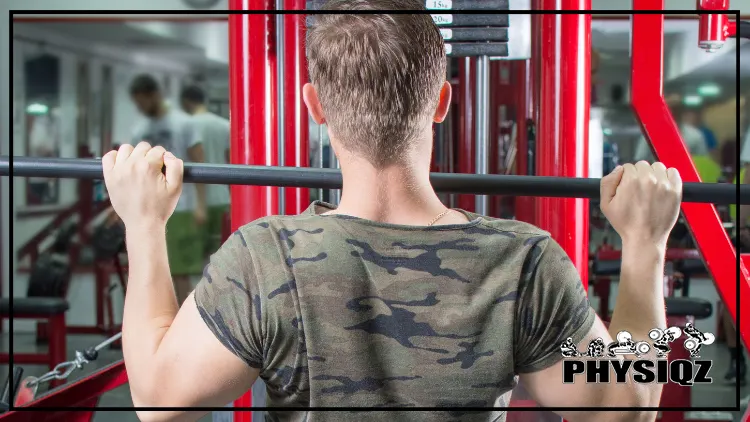
On the close grip lat pulldown muscles worked differ slightly from other lat pulldown variations like the wide grip, cable, and V-bar, or even when using a little-known angle trick.1 But, in general, they all work a similar set of muscles with each targeting slightly different areas better than the rest.
Through this article, an understanding of how these different types of pulldowns work biomechanically will be garnered, as well as which movements are best for targeting specific areas of the body.
Even beyond that, when using a little-known angle trick for the close grip lat pulldown, muscles worked change quite substantially, helping anyone get a wider and stronger back.
Lat Pulldown Muscles Engaged: Muscles Targeted by Pull Downs (Narrow Grip, Wide, Machine, All)
The lat pulldown is a core part of any starting strength routine for beginners. That being said, there are quite a few different muscle groups that are used to perform the lat pulldown. These include:
- Latissimus dorsi (lats)
- Biceps, forearms, and brachialis
- Rear delts, rhomboids, and traps
- Stabilizers like the teres major
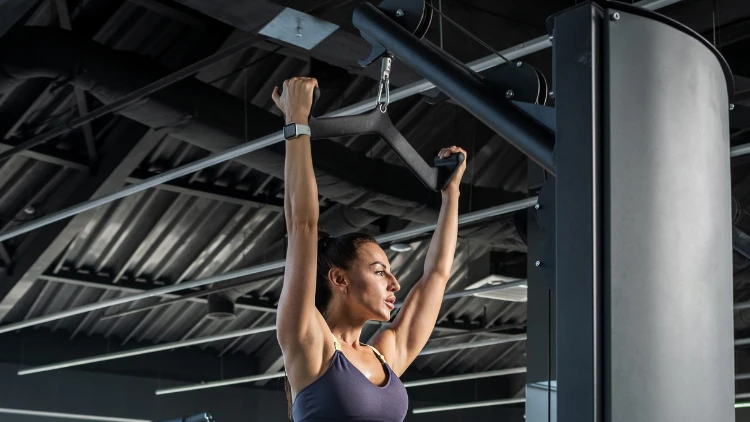
Source: Sergey Nazarov via Canva.com2
To better understand which of these muscle groups have the greatest effect on the muscles targeted by the close grip lat pulldown, an understanding of how they affect the movement should be had.
The Latissimus Dorsi (Lats) Are The Primary Mover
The latissimus dorsi is the primary mover in any type of pulldown, regardless of whether it’s a close grip or wide grip; this is primarily where it differs from deadlifts. As such, it receives the greatest amount of stimulation during this movement.
In addition to being the primary mover, the lats are also responsible for helping a person to stabilize their body as they perform the movement. The lats are not the hardest muscle to grow, but they can be tricky for some so doing pulldowns is one of the best ways to bring them up.
The Trapezius (Traps) & Teres Major Help To Adduct The Arm
The traps and teres major are both important muscles that work together to adduct the arm during a close grip lat pulldown. As such, these two muscles receive quite a bit of stimulation as well. Additionally, they help to stabilize the scapula and improve posture while performing the movement.
The Posterior Deltoids (Rear Delts) & Rhomboids Help In Scapular Retraction
The rear delts are important in any pulling movement, but typically see the most activation when in a horizontal pulling exercise like the cable row or bent-over row.
For the lat pulldown, while it is still activated, it is not activated to the same extent, so a person seeking to get posterior delt gains should look elsewhere than the close grip lat pulldown, especially when one has bad shoulder genetics.
The rhomboids are a little-known muscle group that many people see as the little brother to the traps. This is a relatively accurate assessment – they are located in the middle of the back from the center of the scapula (upper back area) and go down the spine.
They have a pentagonal shape, with the upper point reaching toward the base of the skull and flaring out to the left and right moderately.
Overall, these two muscle groups benefit the lat pulldown primarily through scapular retraction; retracting the scapula while performing a pulling motion is a must, and especially for the lat pulldown, many people do not actively think about doing so.
This primarily has the benefit of acting as a ‘cue’ to properly perform the movement; however, there is evidence that actively retracting the scapula does not have much effect on trap or rhomboid activity, in reality.3
The Biceps, Forearms, & Brachialis Help Guide The Pulldown
None of these three muscles are considered primary movers for the lat pulldown, or even secondary movers, but they are still relevant to the movement as a whole.
Think about it this way: if a person didn’t have forearm muscles, or upper arm muscles, they would find it extremely difficult to bend their elbow to finish the concentric portion of the movement, knocking out effectively 50% of the exercise.
Regardless, the biceps and brachialis, which are located underneath the biceps, both aids in elbow flexion, and the forearms are required to grip the bar with any level of strength.
Especially when getting into heavier lat pulldown weights, these muscles become more and more important; weak forearms or biceps would disallow someone from moving up in weight.
But, that being said, some people prefer to use lifting straps to do heavy lat pulldowns, which can be effective for hitting the back harder than other exercises.
A Sample Lat Pull-down Diagram With the Muscles Worked Highlighted
In the diagram above, the lat pulldown is illustrated with the various muscles being used highlighted. The darker the red used to highlight a specific muscle group, the more of a primary mover it is.
For example, the latissimus dorsi, or lats, are the primary mover for this exercise; they are the largest muscle on the back and do the bulk of the weightlifting here. Additionally, the traps and teres major are both heavily involved in adducting the arm once the concentric portion of the movement is finished.
The posterior deltoids (rear delts) and rhomboids are present to ensure proper scapular retraction, while the biceps, forearms, and brachialis help guide the pulldown.
In this specific example, the diagram shows a wide grip pulldown, which ultimately prioritizes lat and trap engagement more than the other muscle groups.
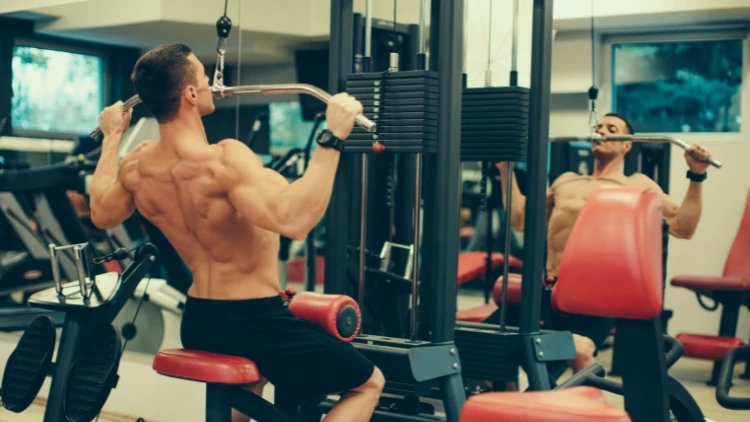
Source: eclipse_images via Canva.com4
One thing to note is that mentally focusing on the specific muscle group that a person wants to ‘target’ the most does elicit benefits; research has shown that weightlifters can increase the activity of a specific muscle when performing the pulldown, helping to develop a better mind muscle connection with specific muscles.5
The Different Types of Pull Downs (Muscles Worked) Compared
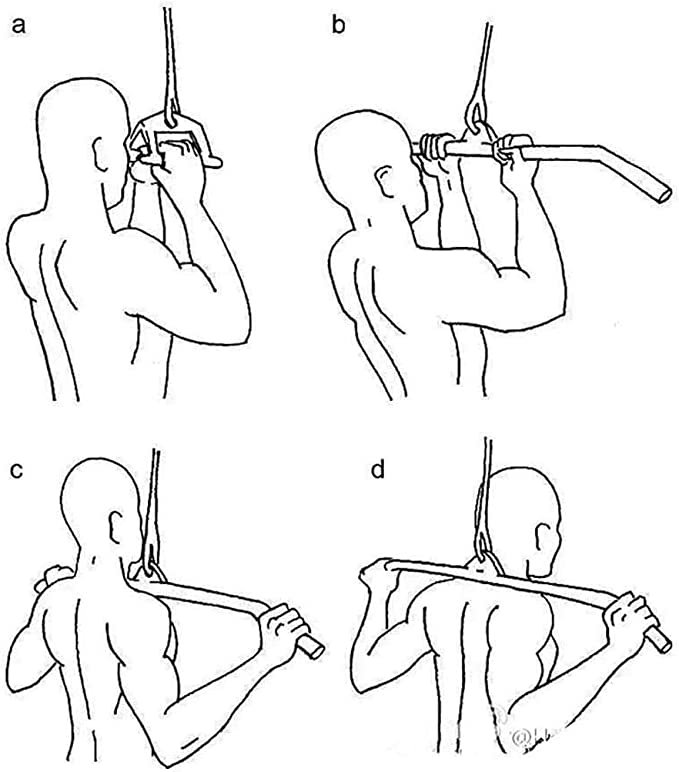
Hand positions examined during the lat pull-down: (a) close grip, (b) supinated grip, (c) wide grip anterior, and (d) wide grip posterior.6
Before going into the specific variations of the pulldown to better understand how the muscles targeted by the close grip lat pulldown differ from others, take a peek at the above diagram that highlights the main grips recommended.
Pulldown ‘a’ is a close grip variant, where the palms are facing inward in a neutral grip, simply meaning that the arms are halfway between being pronated and supinated.
‘B’ is also a close grip variant, but the palms are facing toward the body, meaning they are pronated. This targets the muscles in the body slightly differently than a close grip, neutral pulldown.
‘C’ and ‘D’ are both wide-grip pulldown variants, but both have slightly different effects on the body, with many different fitness critics debating on the benefit of behind-the-head pulldowns when compared to pulldowns that end on the chest.
These types of pulldown have been seen to activate the latissimus dorsi more so than other pulldown and rowing variants, meaning they are best for developing the lats.7 However, ‘d’, the behind-the-neck variant, has been overall shown to be a more ineffective version of ‘c’, but this may differ by the individual.8
Regardless, to understand the different benefits and reasoning for completing a different type of pulldown, let’s begin with the muscles targeted by the close grip lat pulldown.
Close Grip Lat Pulldown Muscles Worked
In the close grip lat pulldown muscles worked differ significantly from other pulldown variants, regardless of if the arms are pronated or supinated. Due to the fact that the pulldown requires a narrower grip, there is more of a focus on the trapezius and rhomboids.
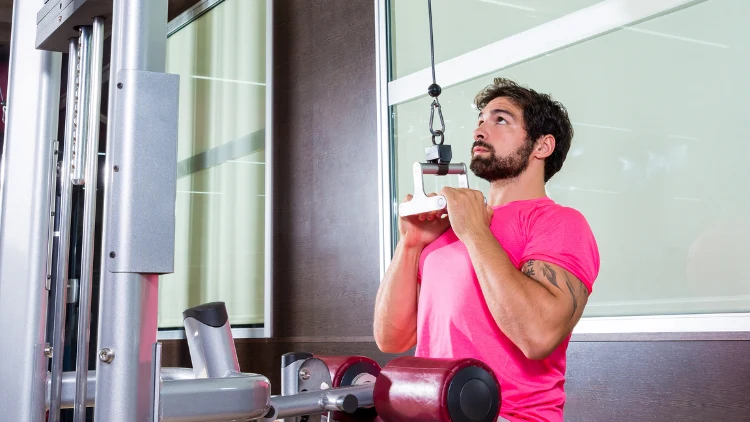
Source: Lunamarina via Canva.com9
The tighter grip forces the elbows to tuck in towards the sides at the bottom of the movement, requiring greater scapular retraction, as well as a slight lean back at the bottom of the movement, which prioritizes these muscle groups slightly more than in a standard pulldown.
Having a different arm position – neutral, pronated, or supinated – will slightly affect the muscles worked, too. A supinated grip, where the arms are facing inward, will target the biceps and brachialis more than other variants.
This is because the upper arm receives a bit more of a stretch when supinated than in other cases; the angle trick that will be discussed further below also benefits from a greater stretch when compared to other pulldown variants.
A neutral grip, on the other hand, will not differ too significantly from an overhand (pronated) grip, but it will target the trapezius and rhomboids slightly more. As part of a 4 day workout split, adding in this pulldown variant is a good idea.
Wide Grip Lat Pulldown Targeted Muscles (Wide Grip Pulldown Targeted Muscles)
The wide grip pulldown specifically is excellent for overall back development, as it allows the lifter to really feel a deep stretch in their lats. It helps build strength and power by allowing the person to lift heavier weights, with the arms being pulled further apart than in other variants.
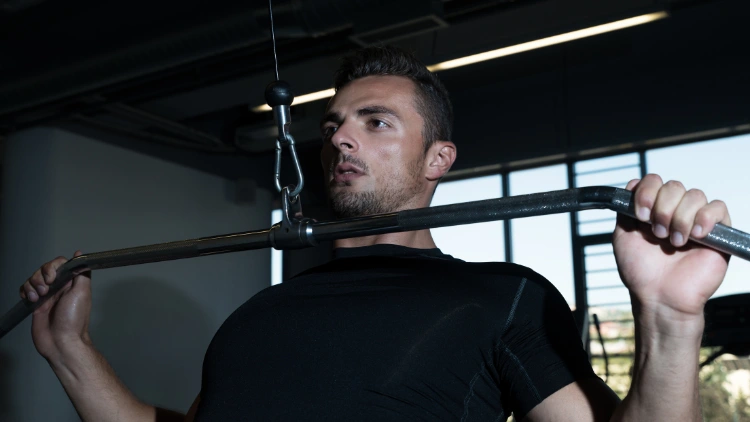
Source: Ibrakovic via Canva.com10
The wider grip creates a longer range of motion and stretches the muscle more so than in a close grip position. It primarily requires a greater stretch in the latissimus dorsi than other grip variants, so for a person who wants to build up to doing a pull-up as part of a push pull legs routine (PPL), doing a wide-grip lat pulldown makes the most sense.
Similar to the close grip lat pulldown, muscles worked will change based on arm pronation. A neutral grip will focus slightly more on the rhomboids, traps, and rear deltoids, while a supinated grip will place more focus on the brachialis and biceps.
In fact, out of multiple pulldown versions, the wide grip pronated grip has been shown to offer the greatest lat contraction.11
Do note, however, that most people don’t have the mobility to do a ‘chin-up grip’ with the wide lat pulldown; it is simply too difficult to internally rotate their arms that far.
The pronated, or overhand, grip, on the other hand, is what most people tend to use when doing the wide grip pulldown, as it prioritizes the latissimus dorsi, further aiding those trying to get the V-taper many want.
Wide Grip Lat Pulldown vs Close Grip
Ultimately, the choice between close grip and wide grip pulldowns comes down to what a person’s fitness goals are. If a lifter wants to prioritize building up strength for a pull-up eventually, or if they want to target the lats for more of a V-taper in appearance, then wide-grip pulldowns are the way to go.
The close grip pulldown, on the other hand, is better if a lifter wants to focus on their traps and rhomboids more so than their lats; as it places more stress on those muscle groups due to the arm position and grip used.
The wide grip may offer better lat contraction, but some research has shown that as long as a person has a pronated grip, the width of their grip may not significantly affect this.12
Overall, the close grip lat pulldown and wide grip lat pulldown both have their uses depending on a person’s fitness goals. If you are looking to target your lats more for either aesthetic or functional purposes, then the wide grip is a better option.
However, if you want to focus more on building up strength in the traps and rhomboids, then the close grip lat pulldown is a better option.
In the end, it’s important to remember that all of these exercises have their place and can be used to benefit a lifter depending on what they are looking to achieve. It is best to experiment with both wide and close grip pulldowns and find a combination of pulldown exercises that work best for the individual.
Wide vs Neutral Grip Lat Pulldown
While some people wonder which is better between a neutral grip lat pulldown and a wide grip, in reality, these are completely different terms that are difficult to compare.
As aforementioned, a neutral grip can be used for most pulldown variants – a person who goes to the gym often, they have probably seen a close grip attachment for the pulldown machine that places the arms in a neutral grip, as well as a longer bar attachment with handles on the end to also leave the hands in a neutral grip.
Meaning, for both the close grip lat pulldown and the wide grip pulldown, a person can use a neutral grip to target their traps and rhomboids more than with a pronated or supinated grip.
Lat Pulldown vs V Bar Pulldown
The v-bar pulldown is a bit different from a standard lat pulldown; most people refer to the v-bar as a lat pullover, using an overhead cable machine rather than the lat pulldown cable machine.
In the v-bar pulldown, a person stands a few feet back from the cable, slightly bends at the knee, and stretches their arms over their head. They then isolate their latissimus dorsi while keeping their arms straight to pull the weight down towards their waist.
This movement is phenomenal at isolating the lats, especially when compared to the traditional lat pulldown, but they are ultimately different movements. Adding this movement on top of a traditional pulldown would make for a phenomenal part of a progressive overload workout plan.
Are Lat Pulldown Machine Muscles Worked Any Different? (Fixed Lat Pull-down Machine)
Between the lat pulldown on a cable machine and a fixed lat pull-down machine, which uses a stack of weights, there are not really many differences in the main muscles being used.
Both types of lat pulldown require the individual to retract their scapula to get optimal muscle recruitment, using the lats, rhomboids, traps, and arms to complete the movement.
However, similar to a lot of other machines, the fixed lat pull-down machine allows the lifter to target these main movers more than in the cable lat pulldown. Machines tend to minimize the requirement of stabilizing muscles, like the rear delts or teres major, so they target building the V-taper slightly better.
However, using solely the fixed lat pull-down machine may ultimately hinder overall muscle growth; ignoring stabilizing muscles has diminishing results in the long-term of bodybuilding.
The Bent-Over Lat Pull & Their Muscles Worked
The bent-over lat pull is very similar to the v-bar pullover; in fact, it is the same movement. A person is free to use whichever attachment they want when doing the pullover, but it requires the individual to slightly bend over to stretch the lats to their max capacity.
As aforementioned, the lat pullover prioritizes stretching the latissimus dorsi much more than the traditional lat pulldown.
Ultimately, since it requires no elbow bend, the forearms, biceps, and brachialis are minimally engaged, and with there also being lesser scapular retraction, the rhomboids and traps have less of an effect on the movement, as well.
The bent-over lat pull is perfect for an individual who wants to add some extra lat-targeted exercise on top of their back day that already has a pullup or pulldown as the main movement.
How To Get Better Muscle Engagement Using The Angled Lat Pull-Down
One lat pulldown variant that hasn’t been discussed yet is the angled lat pull-down. This pulldown requires a bit more setup than other pulldowns because it requires two cable machines side-by-side.
To set it up, set the cables up with a handle on each one at about mid-chest height. Sit down on the ground and stretch the arms up to reach each of the handles – the goal here is to be seated, legs extended to stabilize the body, with lats stretched as the person reaches overhead for the handles.
From here, a person can use whichever grip they want – neutral, pronated, or supinated, depending on what they are targeting.
This angled lat pull-down variant gets quite a bit of stretch in the lats, more so than a traditional lat pulldown, because the lats are stretched maximally at the starting point of the movement. It also uses individual handles for each hand, which helps to correct any muscular imbalances as one progresses throughout the movement.
Overall, the lat pulldown offers a litany of benefits for lifters who are looking to develop a V-taper or overall upper body strength. In the close grip lat pulldown muscles worked primarily target the rhomboid and trapezius muscles more so than other pulldown variants, so for someone who wants to target their posture and upper back definition, the close grip pulldown variant makes the most sense.
Frequently Asked Questions
Is There A Barbell Pull Down?
No, there is not a barbell pull-down. A pulldown can only be completed on a machine or a cable machine because they use weighted resistance to force the lifter to ‘pull’ the weight upwards, fighting against gravity; a deadlift workout is the closest to an alternative, but it is more of a barbell pull up, anyways.
Is the Wide Grip Cable Pulldown Different From the Wide Grip Front Lat Pulldown?
A wide grip front lat pulldown refers to a pulldown using a wide grip with a long, straight bar, while a wide grip cable pulldown refers to using individual handles with a wide grip. As aforementioned in the section on the angled lat pulldown, using individual handles forces the individual to develop better overall muscular balance, as well as forcing the stabilizing muscles (the teres major, primarily) to help more than the wide grip front pulldown.
What Are the Main Lat Pulldown Muscles Worked?
The main muscles worked in the lat pulldown, as aforementioned, include the latissimus dorsi, the rhomboids, the traps, the biceps, and the forearms to some extent. These muscles can be considered the ‘main movers’ in the lat pulldown because the movement requires a stretch of the lats, scapular retraction using the rhomboids and traps, and closing the movement out with a bend at the elbow using the biceps and forearms.
References
1Creative-Family. Canva. Accessed 13 April 2023. <https://www.canva.com/photos/MADCHF3DBSc-man-performing-lat-pulldown-at-the-gym/>
2Nazarov, Sergey. “Young woman working out on lat pulldown machine at gym.” Canva. Accessed 6 April 2023. <https://www.canva.com/photos/MAEhPwFuuaI-young-woman-working-out-on-lat-pulldown-machine-at-gym/>
3Lehman, G., Buchan, D., Lundy, A., Myers, N., & Nalborczyk, A. (2004). Variations in muscle activation levels during traditional latissimus dorsi weight training exercises: An experimental study. Dynamic Medicine, 3, 4. <https://www.ncbi.nlm.nih.gov/pmc/articles/PMC449729/>
4eclipse_images. “Lat pulldowns.” Canva. Accessed 6 April 2023. <https://www.canva.com/photos/MAEJMbseqgI-lat-pulldowns/>
5Snyder, B., & Leech, J. (2009). Voluntary increase in latissimus dorsi muscle activity during the lat pull-down following expert instruction. Journal of Strength and Conditioning Research, 23(8), 2204-9. <https://pubmed.ncbi.nlm.nih.gov/19826307/>
6“[PDF] A Comparative Electromyographical Investigation of Muscle Utilization Patterns Using Various Hand Positions During the Lat Pull‐down.” Semantic Scholar, 1 November 2002. Accessed 6 April 2023. <https://www.semanticscholar.org/paper/A-Comparative-Electromyographical-Investigation-of-Signorile-Zink/61b9ace090e4c0d3f5833f2c534db5e9279f5af9>
7Handa, T., Kato, H., Hasegawa, S., & Okada, J. (2005). Comparative electromyographical investigation of the biceps brachii, latissimus dorsi, and trapezius muscles during five pull exercises. Japanese Journal of Physical Fitness and Sports Medicine, 54(2), 159-168. <https://www.researchgate.net/publication/273714919_Comparative_electromyographical_investigation_of_the_biceps_brachii_latissimus_dorsi_and_trapezius_muscles_during_five_pull_exercises>
8Sperandei, S., Barros, M., Silveira-Junior, P., & Oliveira, C. (2009). Electromyographic analysis of three different types of lat pull-down. Journal of Strength and Conditioning Research, 23(7), 2033-8. <https://pubmed.ncbi.nlm.nih.gov/19855327/>
9Lunamarina. “Man Workout at Gym.” Canva. Accessed 6 April 2023. <https://www.canva.com/photos/MABB0U_2w8c-man-workout-at-gym/>
10Ibrakovic. “Lat Pulldown Workout.” Canva. Accessed 6 April 2023. <https://www.canva.com/photos/MAC__ekN5ro-lat-pulldown-workout/>
11Signorile, J., Zink, A., & Szwed, S. (2002). A comparative electromyographical investigation of muscle utilization patterns using various hand positions during the lat pull-down. Journal of Strength and Conditioning Research, 16(4), 539-46. <https://pubmed.ncbi.nlm.nih.gov/12423182/>
12Lusk, S., Hale, B., & Russell, D. (2010). Grip width and forearm orientation effects on muscle activity during the lat pull-down. Journal of Strength and Conditioning Research, 24(7), 1895-900. <https://pubmed.ncbi.nlm.nih.gov/20543740/>